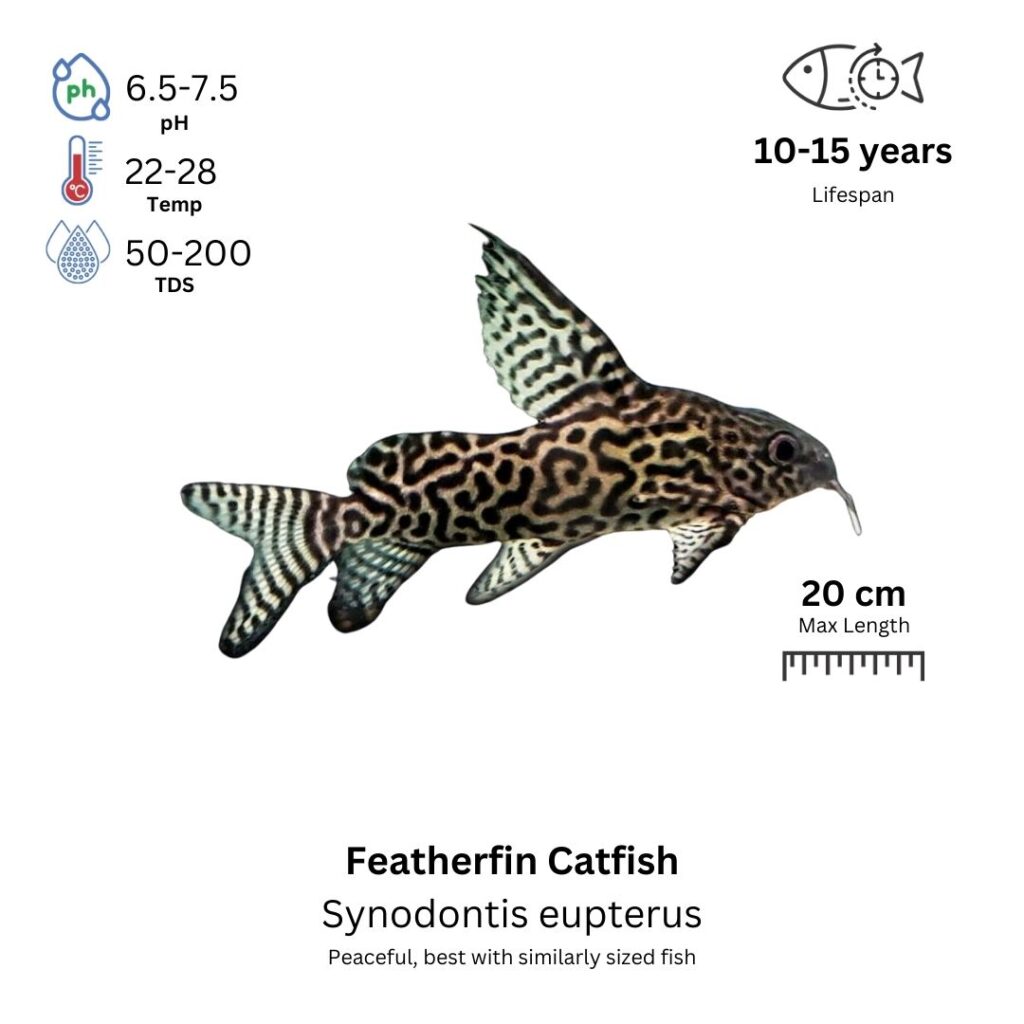Featherfin Catfish
Arnoldichthys spilopterus

Description
The Featherfin Catfish is a distinctive and striking species of catfish known for its elegant, long, flowing fins, particularly the large, feather-like dorsal fin, which gives the fish its common name. It has a smooth, silver-gray to brownish body, often with darker spots or patterns across its sides. The long, flowing fins are a major feature of this species, especially the dorsal fin, which can spread out like a feather. Its whisker-like barbels on the mouth are used to sense food in the environment, and it has a relatively flat head, typical of many catfish species.
Habitat Origin
Native to the freshwater rivers and streams of Central Africa, particularly in countries like Sudan, Uganda, and Congo. These fish are typically found in slow-moving waters, where they live in the deep areas of rivers or lakes, often around submerged rocks and logs that provide shelter. They prefer slightly acidic to neutral water, with a moderate water flow, and a well-oxygenated environment.
Aquarium
Ideal Number in Aquarium: Best kept singly or in pairs. Larger tanks with multiple hiding spots are ideal for their well-being.
Favorite Food

Featherfin Catfish are omnivores and will accept a wide variety of foods. They can be fed high-quality sinking pellets, live or frozen foods such as brine shrimp, bloodworms, and daphnia. They will also consume algae, detritus, and plant matter, so providing algae wafers or blanched vegetables like zucchini and spinach can be beneficial. A varied diet is important to ensure they stay healthy and active.
Behavior:
Featherfin Catfish are peaceful but tend to be nocturnal. During the day, they often prefer to hide in caves, crevices, or behind plants and rocks. At night, they become more active, swimming around the tank, foraging for food, and exploring their environment. They are generally calm and non-aggressive but can become territorial, particularly during feeding times. These fish are not known to be aggressive toward other species, but they should be housed with similarly peaceful tankmates that do not pose a threat or stress them.
Special Care:
Featherfin Catfish are hardy but require stable water conditions to thrive. They need a tank with plenty of hiding spots, such as caves, driftwood, and plants, as they enjoy having places to retreat to during the day. They are sensitive to poor water conditions, so regular water changes and good filtration are essential to keep their environment clean. The soft, fine substrate is best, as they often forage along the bottom for food. Strong water currents should be avoided, as they prefer moderate flow.
Compatibility with Other Fish:
Featherfin Catfish are compatible with many peaceful species, making them an excellent addition to community aquariums. They can be housed with other non-aggressive fish like tetras, rasboras, and peaceful cichlids. However, they should not be kept with overly aggressive fish or very small species that may be intimidated or preyed upon. They are generally peaceful but can become territorial with other bottom dwellers or species that compete for food in the same areas.
Breeding Tank Setup
Setting up a dedicated breeding tank is highly recommended for Featherfin Catfish due to their territorial nature and sensitivity during spawning. A tank of 80–100 liters (20–26 gallons) provides enough space for swimming and establishing territories. Maintain pH between 6.5–7.5, temperature between 26–30°C (79–86°F), and hardness around 4–12 dGH. Use a gentle sponge or internal filter to ensure clean, oxygenated water without creating strong currents. For spawning surfaces, include smooth rocks, flat stones, or ceramic caves. Fine gravel or sand can be used as substrate, though plants are not essential. Standard lighting with 10–12 hour cycles works well, and shaded areas or caves will help reduce stress.
Conditioning for Breeding
To encourage breeding, condition the Featherfin Catfish with a high-protein, varied diet. Offer live or frozen foods such as bloodworms, brine shrimp, daphnia, and earthworms, supplemented with high-quality pellets and flakes. Feed this diet consistently for about a week before breeding. Perform a 20–30% partial water change one or two days prior to breeding, and consider raising the temperature slightly to around 28°C (82°F) to simulate seasonal cues that trigger spawning.
Spawning Behavior
Spawning generally occurs early in the morning or late at night, following successful conditioning and environmental adjustments. Males will begin to chase and display to females, who will then lay 100–300 adhesive eggs on smooth surfaces like rocks or caves. It is essential to remove the adults shortly after egg-laying, as they may consume the eggs or the fry. Observing subtle breeding behavior and acting quickly to separate the breeders is key to preserving the clutch.
Fry Hatching
The eggs hatch in approximately 3–5 days, with warmer water accelerating the process. Once hatched, fry will stay relatively still while absorbing their yolk sacs, becoming free-swimming after 3–4 days. At this point, begin feeding them infusoria or liquid fry food. After about a week, transition to newly hatched brine shrimp or finely crushed flakes. Maintain high water quality through 10–15% water changes every 2–3 days, and ensure stable temperatures within the optimal breeding range using a gentle sponge filter for minimal disturbance.
Key Notes & Stress Prevention
Featherfin Catfish are ready to breed at around 1.5 to 2 years of age. Males tend to be smaller and more active, with slightly more intense fin coloration, while females are rounder and larger, especially when gravid. To avoid stress, do not overcrowd the breeding tank, and keep environmental changes minimal. Sudden fluctuations in temperature or pH, as well as the presence of aggressive tankmates, can disrupt breeding behavior and jeopardize successful hatching. Providing a peaceful, consistent environment will lead to the best breeding outcomes.
